This post is a very basic guide I have written to help tenants and homeowners with mould related damp problems. You don’t need any technical knowledge to understand this stuff. I meet lots of people who are pulling their hair out over mould and really – once you have a handle on why it happens you can stop the problem coming back – read on…….
My council house is damp – The council say it’s my fault – what can I do about it?
This is a common question and is being asked of me more and more.
Of course damp cannot be diagnosed over the phone or via email, but over the past few years I’ve noticed a trend and can help lots of tenants in the following paragraphs.
Get a cup of tea or coffee and take a seat.
I am going to talk about humidity – please bear with me because mould loves humidity.
The chances are you are sitting in a room with either no fireplace or a fireplace, which is bricked up or has an electric fire in it. Looking around you can see that the house is double glazed with Upvc windows and doors. Think for a minute… is this how the house looked when it was built? The answer is probably not. My guess is that the house had ‘open’ fires, especially if you live in a mining area like I do here in Yorkshire. The windows were wooden or metal framed and they were quite drafty back then.
So the first thing to think about is how the house has changed since construction; what we’ve done is reduce ventilation by a huge margin. Coal fires were used in the past to heat water as well as keep the house warm (fire back-boilers are common in post war housing – we had one). When the fire is burning all the breathed and re-breathed air in the house, along with any water vapour, is sucked up the chimney and replaced with fresh air sucked in, via the ill-fitting windows and doors (that’s why they were drafty). Making a fire was a skill, but better still was keeping one just on the embers, so it could be re-started quickly when required (this is important as we’ll see later).
So this means that the first point is this; Old houses were far better ventilated than newer houses. Now for the second big change.
This is the social change we’ve seen in the past few decades. Just think about the family living in the original house when it was built for a moment; they had to heat the water with a coal fire…. It was quite a chore and took ages. Thus there was a ‘bath-night’ in many homes. Water was often shared, so the amount of water vapour produced via bathing was low. By the same token laundry day was a similar trial for Mum (this is how it was).
There were no tumble dryers or radiators to dry clothes on and so most people dried clothes outside; in communal drying areas or, used the launderette in winter. The amount of water vapour produced was massive, but it wasn’t produced in the home (even when it was, the vapour went straight up the chimney).
Look at us now; showers every day or sometimes twice a day. Hair washes daily and of course we never wear the same clothes twice, without them going through the wash. Hot water is available at the flick of a switch; the kettle, the shower; the microwave, the steamer; the fryer…. The list is endless.
Where mould is involved – One and one makes three…
If we add together the changes in the building; sealed up at every level, with the changes to our living standards, we have more than a double whammy of problems; No ventilation + much more water vapour = Mould city.
These two revolutionary changes in housing and living standards combine to result in dwellings with very high humidity and a tendency towards condensation and mould.
My council house is damp – what can I do?
Well of course I am not going to say open the windows and stop breathing and washing…
We are stuck with the house as it is; fireplaces are not going to make a comeback anytime soon and despite what our grandparents may say – it was not better in the old days (I bet some of them ended up a bit smelly after a few days without a bath).
The good news is that we can reduce the problem and in many cases cure it without expensive intervention.
That is because having read the above we now know the causes (there are other issues but we’ve covered the main ones).
First of all, having recognised that excessive humidity is the cause – how can we lower that?
Leave your tea and take a quick look in the kitchen. Is there an extractor fan in the wall or a cooker hood linked to a ducting kit (that means the hood pushes air outside via a duct and a vent on the wall outside or on the roof).
If there isn’t then we need one fast. If there is one be honest… do you use it? By that I mean do you switch it on every time you cook, use the washing machine, wash the pots or boil a kettle…. No? I thought not, but that’s alright – the reason we tend not to use the extraction diligently, is that most of us have never been told how important extraction is in modern homes (even if your house is very old – it is now modern because you live in it). I hope that after reading this post you will understand that the extractor fan is your best friend.
Think about what I wrote about the house and the changes we’ve made to it… we’ve ‘designed in’ excess humidity and now the house needs your help. So, use the fan every time you make water vapour in the kitchen. In addition, think about this; the fan extracts air (and the water in it), at a set rate we measure in litres per minute. For a very easy example let’s say we have a fan that can shift 600 litres a minute of water-logged air from a room of 6000 litres. That’s 10% per minute or ten minutes to shift 6000lt. However, if we have the internal kitchen door open ,so that in effect the kitchen and lounge are one big room, we have more than doubled the size of the kitchen, in relation to the performance of the fan. I hope this makes sense, but in doing that we have made the fan relatively smaller and less efficient. So close the door when you are working in the kitchen and have the fan/cooker hood on.
Leaving the kitchen now we need to pop into the bathroom. Is there a fan in the wall or ceiling? If not – we need one fast!
The bathroom is a veritable water vapour production line. A hot shower or bath will produce trillions of water molecules, which are warm (energetic), so they skip from liquid state into air and form water vapour. Flushing the toilet – brushing teeth and that wet towel on the radiator are blowing off similar amounts.
Our activity in a bathroom may last only a minute or two, so remembering to be diligent and switch a fan on and off is a chore in itself; so ideally we need an automated fan. Usually this means a fan activated by the light-switch. It should come of by itself and stay on for a few minutes after we turn the light off. That’s because it takes much longer for a fan to get all that water vapour out of the bathroom, than it takes for us to make it in the first place.
Remember what I wrote about closing the door? It applies even more here. Warm water vapour is under pressure (damp specialists like me call this vapour pressure), and it wants to spread out down its pressure gradient (into your bedrooms, lounge and hallway – where is helps mould grow). Always close the bathroom door behind you and tell the kids – it’s important
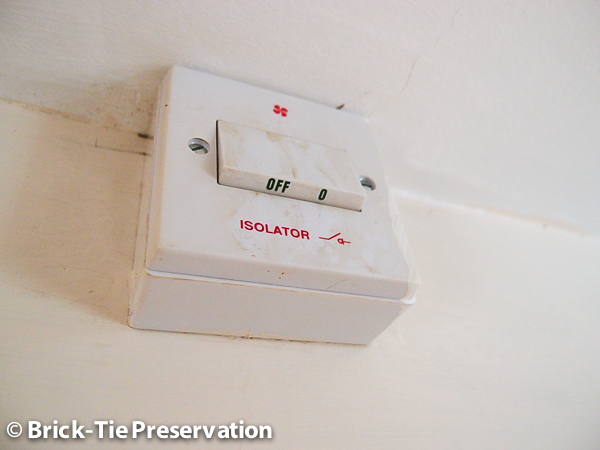
This isolator switch is for the electrician and should be in the on position (you will find this above the bathroom door near the ceiling).
If the kitchen or bathroom fan seems to be broken, check the isolator switch to make sure it is turned on (this may be above the bathroom door). It may have been turned off because it was noisy; get it fixed. Maybe you or another family member thought that when the bathroom fan stayed on, this was a fault – it’s not.
We’ve covered the three most important causes of mould in homes – missing, broken or unused extraction.
My council house is damp – what can I do?
Right then, say we have checked the above and actually they were fine; fans all present and correct; isolators on; doors closed. (external vents unobstructed – see below).
Still having damp problems? We need to dig a bit deeper.
Let’s look at the windows. Are there small horizontal vents at the top of the frames? There should be some of these ‘trickle vents’. They should be open and never closed. Why? In themselves they don’t actually provide much in the way of ventilation; heat loss or gain. Air is not inclined to just rush about the place just because you have a little slit in the frame – especially if it’s behind net curtains.
What the trickle vent does is provide a route for ‘make-up’ air. This air is the equivalent of the drafts in old windows, caused by the suction of the ‘coal fire’ when it burned. We don’t have that now, but we do have extraction in the bathroom and kitchen. When those fans are working; pushing/sucking damp air out of the house, we need a handy place for new fresh and dryer air to get in to replace it.
A lack of trickle vents or closed vents encourages drafts at lower level (where you’ll feel it), and reduces the efficiency of the extraction – so open them all now.
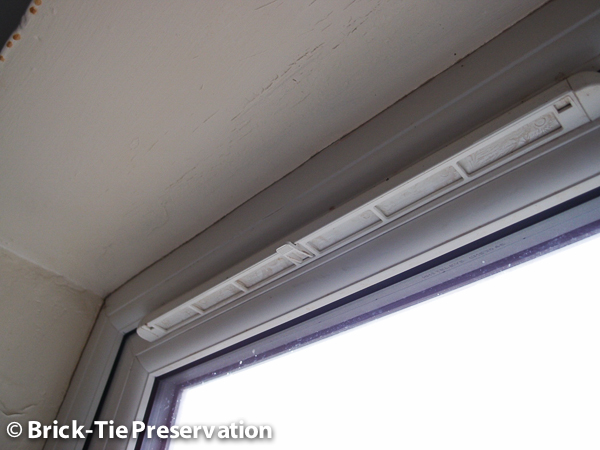
Closing a trickle vent is not a good idea because dryer air from outside should come in here when your extractor fans are working
We should be at a point where the ventilation is now adequate – because we know ‘efficient extraction in the kitchen and bathroom is crucial’.
In some cases we may have the above – good extraction – open trickle vents. Still problems?
Occupancy and Moisture production.
If the house has a larger family then of course the amount of water vapour produced in it will be higher than it is in a house occupied by a single person or couple (usually); more laundry – more baths and more cooking. Is there a new baby? Bottle sterilisers steaming all day long produce a vast quantity of water vapour – as does all the extra laundry.
Have a large dog or two? – They breathe out as much water vapour as a teenager. Do we keep tropical fish? An extra bath of warm water with an air pump blowing air through it acts like a giant humidity-producing machine– yes really (I have two by the way).
The solution is not infanticide or the dog warden.
Let’s just make sure we are doing the best possible to help the house cope with the extra demands on it, made by our extra kids or pets. This means for example; making sure that the fan in the kitchen is on when the steriliser is on – and the internal door closed. If some drying of clothes, dog blankets and such is needed, do not use all the radiators around the house or place drying racks in bedrooms or the lounge/hall.
The best place to dry clothes indoors (if you really have to), is either the kitchen or the bathroom. This is because the heat generated by the heating in these rooms provides the energy to dry the clothes (creating evaporation), but most importantly, you can close the door on the water vapour, whilst the fan in either room gets the water vapour out of the house, where it can’t do any harm.
As for the tropical fish tank well, on its own it should be fine – as should Hector and Rex the Alsatians – but we need to accept that they do increase the moisture load, so that means we have to be diligent and follow the previous advice, so that we give our house the best chance of remaining mould free.
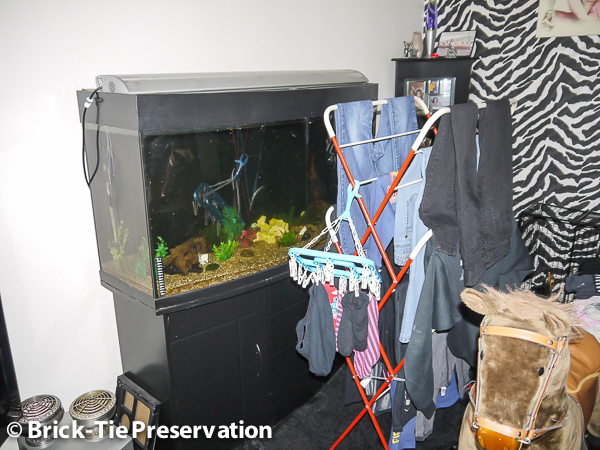
The clothes are heavy when placed here and light when dry – that loss of weight is water turned to vapour. The tank is a constant source of water vapour too – especially if heated.
The above brings us onto the final sticky problem.
Heating and mould growth.
We all have heating don’t we? Most of us have gas central heating with water filled radiators scattered about the house. There may be a gas or an electric fire in the lounge – perhaps a high level electric fan in the bathroom? Maybe there are electric storage heaters instead?
A common saying in the damp specialist lexicon is ‘A damp house is a cold house” There’s truth in that, but you can actually turn it around to…..“A cold house is a damp house”.
I am not going to dig into every aspect of this, because in this post I am concerned about mould. Mould is almost exclusively a problem of the internal environment – not the fabric of the house. You can live in a well-maintained house or a roughly maintained one; a brick house built with cement mortar or a stone house built with lime mortar and still find it is damp and mouldy in any case. Heating is crucial when looking at the internal environment.
Heating or more precisely ‘lack’ of heating raises humidity. It does this because the ability of air to comfortably hold water vapour is entirely dependent on heat. Warm air can hold a lot more water vapour than cold air. So in effect if we cool air we raise its humidity relative to it’s temperature.
This means that for example if we have a relative humidity of say 65% (that means the air is carrying 65% of the maximum amount of water vapour it can hold at that temperature), and we cool it a bit (as per the situation in the spare unheated bedroom or behind a wardrobe), its RH% will increase – it is still carrying the same amount of water vapour; it’s colder and cannot hold water vapour so well – so it is relatively more saturated – so it could now have an RH% of 85% ……even though we have not added any more water vapour to it!
This matters because at high RH’s mould thrives. It can survive at 65% but it will not be happy because it is losing water to the atmosphere – being desiccated by evaporation. In the cold back bedroom or behind that wardrobe, the RH may be 85% and evaporation is slow – so if you are a mould spore that is where you will want to grow.
This is the reason why you will see mould in the corners of rooms – behind furniture and stored articles; it’s cooler there and this is why. Almost all heating, including radiators, heat your rooms by convection. This means that the air touching the radiator is warmed and begins to rise; circulating around the room; warming the walls, the ceiling and us in the process.
Convection heat does not do sharp 90 degrees bends – it circulates in… circles. So the corners and angles of rooms are left unheated – as is any part of a wall behind fixtures. It’s why in a poorly heated and humid house we may find mould behind the kitchen units – in which case there’s rarely any point damp proofing behind them – it is humidity causing the mould… or a leak (see later).
So it is important to maintain the heating at a comfortable level – throughout the house. In these days of fuel poverty, with expensive gas and electric costs, this is a challenge. However, the balance of heating in the house must be maintained and one way of doing this is to leave heating on for longer at a generally lower level (if you must), rather than turning heat off in unused areas and for example, over-heating the lounge.
It is important to remember what I mentioned earlier about vapour pressure. Water vapour is just excitable water molecules, which have escaped the liquid state. This means that are energetic and this means that the water vapour is under pressure. It will penetrate through the house and get into corners – behind furniture and stored article and into the spare ‘cold’ bedroom. In these places the cooler air means cooler surfaces and higher relative humidity. Together these add up to mould, so try your best to balance the heating out. Individual thermostats on radiators will help you do this.
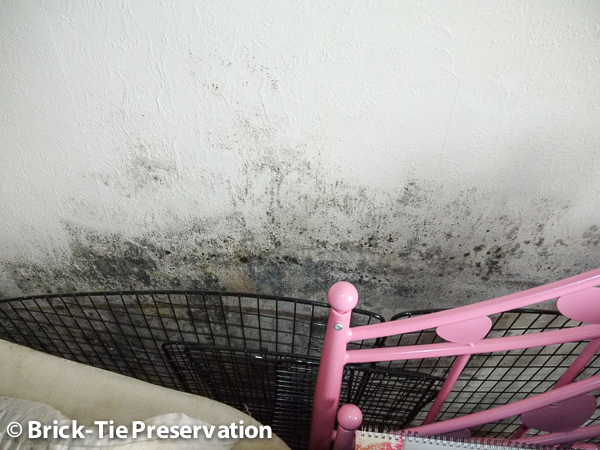
In a humid house the final result may be condensate and mould in areas where the walls are insulated from the warming effects of the heating system – such as behind fixtures and such.
What – you’ve done all the above and …. Help my council house is damp?
There are one or two matters to look at now. Have you been using a gas bottle heater at all ? – if so, get rid of it now, these produce vast amounts of water vapour.
If you have a disability or others do, so that the bathroom is a wet room and the house is occupied 24/7 that will have an impact. In these cases the unavoidable additional water vapour production can be offset, by installing a dedicated ventilation system such as a Positive Input Ventilator – these are great where all of the above is done and individual circumstances mean that mould still arises. However, remember the three major parts of the mould triangle – Ventilation – Moisture production – Heating.
If the mould is confined solely to one area and is stubborn it could be a leak – water penetration – cold bridging and interstitial condensation can occur and this is the time to call in an experienced and qualified expert like me or one of my fellow Property Care Association members. RICS surveyors will also help with advice too as will your local authority if you are a tenant.
Dry Rot.
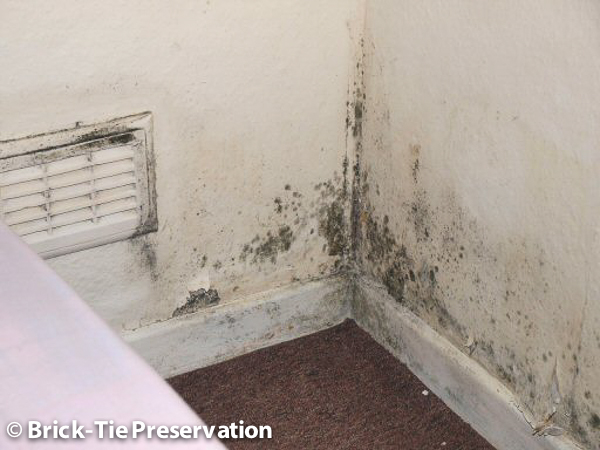
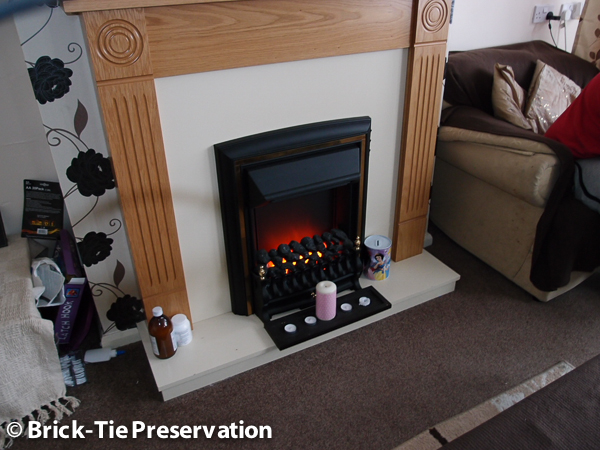
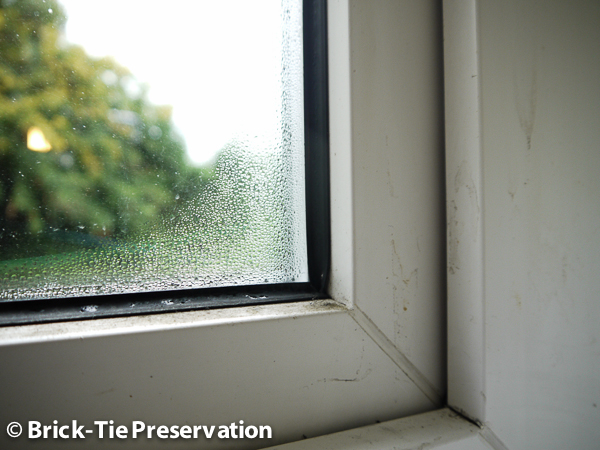
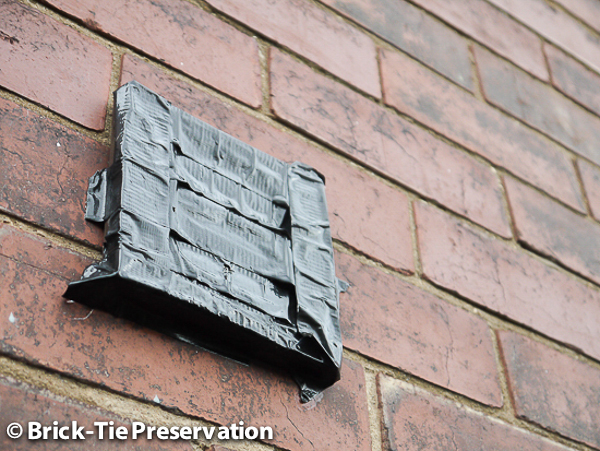
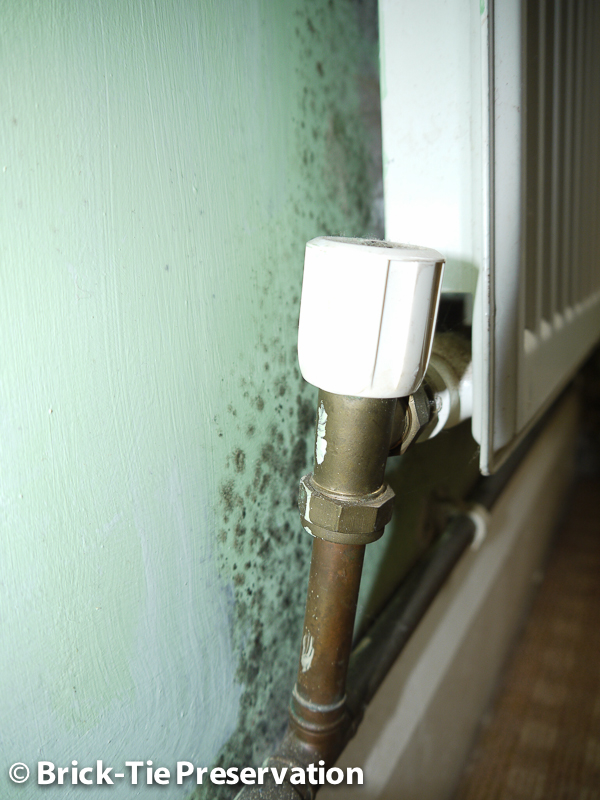
Fantastic written piece, great advice
Thanks Simon – glad you like it – thanks for the support.
Much needed advice to a wide audience Bryan, thank you for the post.
I also find it important to make a point of emphasising to landlords and tenants (albeit individually) to avoid finger pointing and blame shifting over the symptoms. And if instead if they work together they can crack the problem. Possibly some investment from the landlord as well as some lifestyle changes from the tenant = awareness can obviously work wonders.
Best regards,
Mark
Hi Mark,
Thank you for looking in.
You are absolutely right and in practice I spend time as a sort of mediator when it comes to these issues. Sometimes there’s some history already, with perhaps a long trail of previous visits and work. By the time I get involved the tenant may have lost faith in the landlord and the landlord may be feeling beleaguered.
My approach is to spend time, listen to the tenants – get their view and then take it from there. That’s not to say I am on anyone’s side at all. But the first thing I ask when I arrive is – “what is wrong from your point of view and how is this effecting your enjoyment of the house?” This is necessary because in these cases, as you say, we need both Landlord and tenant to recognise that the issue needs cooperation from both parties.
best regards
Bryan
Brian, Ooopps, – Bryan,
Once again you have excelled yourself. Really excellent article!
Your shortened version sounds like it will be a ‘must’ for local authorities/HA’s.
With kind regards
Graham
Graham, you have taught me so much about the internal environment. I only ‘got it’ through your teaching.
The foundations for this post were laid by you, over the years I’ve attended the excellent Property Care Association damp and condensation courses. This has helped me improve my knowledge, by being able to link the facts you gave me, with the many observations I make myself on surveys every day – Good understanding of the fundamentals is crucial to learning by experience; experience is valueless without them – thank you!
I am already looking forward to the next updated course.
Great article..As my Uncle says if we covered ourselves in clingfilm we would not breath so the same goes for a house.If there is no ventilation the house will also die..
Thanks Clare – he’s right of course.. 🙂
Well written piece.
Gordon
Cheers Gordon
enjoyed reading this u came to our house mirkhill rd today confused me a little but get it now ive read through it would recommend this article to some one with similar problems
Hi Carol,
It was lovely to visit you in Selby and I’m glad you’ve found the article helpful. I’ve sent a report to your landlord and hopefully all your mould issues will be history soon.
best regards
Dry Rot.
I presume by passing the buck you work for a Council. My Daughters problems is mold coming up through a concrete floor and the was, this is despite the walls being so called damp proofed only a year ago. Now the damp is rampant right through the house. Result wood floor is once again starting to lift and rot. Black mould coming on the walls damp inside a wardrobe also with black patches of mould.causing green mould on clothes and footwear. her 6 year old son has problems with his chest and I blame the damp for this. The big trouble is the Council know this and hers is not the only hose in the street but the council just turn around and walk away. Not interested only interested in getting there Rent and Council Tax for what better houses in the 60 were pull down. Crap system aided and abetted by corrupt courts and solicitors.
Hi,
Thank you for your comment Tom,
I can well understand your frustration if your house is mouldy and damp. It is quite common for condensation and mould problems to be blamed on rising damp or some other cause. It sounds like your landlord has already tried to do something, by carrying out ‘damp proofing’ so I bet they are as frustrated as you, that the problem remains, despite the money they have spent.
I do not work for a council, if you read ‘about Dry Rot’ you’ll see that. If you have mould inside wardrobes and on walls and clothing then I’m afraid that it is an environmental problem. Have you checked to see if all the ventilation works properly? I can’t diagnose damp problems via the internet but do please check the things I mention in the post above… it may help. Maybe give a copy of the article to your Landlord and see what they say – have they done the right sort of investigation and really diagnosed the issue correctly.
I wish you all the best with your problems and hope that before long the mould you have is cleared up for good.
Thanks again for looking in.
Dry Rot.
Hi Bryan
A superb and informative link, offered in a very tenant friendly manner too !, well done Sir, beats all the high brow “science like” fashion which some do try to offer by way of explanations,
and as I often try to imply, offering an explanation more lay-man like is usually better understood by the person paying the bills for such an often simple remedy,
the only thing I would have added is that I have checked the fuses in extractors / P.P.U’s in the past too, and found them to be either broken, or missing, and have yet to be told when they were ever serviced.
Hi Paul,
Thank you, your comments hit the spot as the post is meant to be easily understood and not too technical – cheers.
You are right about fuses, I find they are removed by tenants because the fan is faulty in some way – on all the time or noisy. Sometimes removed because the tenant is worried about running costs. If tenants don’t know how crucial these fans are and how cheap they are to run, because they’ve never been told, we can’t blame them for this. It’s about having the correct commissioning process in place: Specify the right equipment – install it correctly AND make sure the end user knows how it works and who to contact if it breaks. Also having a good system in place to schedule maintenance and replacements at the proper intervals.
best regards
Bryan
A thoroughly brilliant post. This would be very useful to many customers – would you mind if I was to link this blog on occasions in customer emails or phone conversations?
Christian from Safeguard.
No problem with linking Christian,
If it helps someone I’m happy.
That’s excellent, Bryan. I have already printed this off to show one gentlemen who gets many condensation queries from customers and does indeed find this subject the trickiest to tackle. Hopefully he may provide you feedback, too.
Thank you – that is exactly what it is for.
i am writing to say that my friend has mould in her council house. and all the council is going to do is wash the walls down they are not going to do any more than that. and she has a daughter that is ill and she is not well herself what else is there she can do. please can you help thanks
Hi Wendi,
I cannot comment on individual cases because I haven’t seen the house so I don’t know why there is mould there and how much there is. What I will say though, is that whenever there is mould on walls, ceiling or clothing in a property there is a problem causing it. There is no point in just cleaning it because clearly the cause is still there so it likely to re-grow. I’d want to ask them what caused the mould and what reassurance they can give you that it won’t come back.
If you read my post you’ll see that there are many common problems, which lead to mould in homes. In almost all cases few simple changes will banish it for good.
If you or your daughter are ill you need to see a doctor to get a diagnosis. I hope this helps – don’t hesitate to challenge any landlord about mould. There is an association between damp and mouldy houses and ill health so it is important to get to the cause and fix that as soon as possible. Do remember though that a damp or mouldy house will be home to more of the things which may have effects on health – these include dust mites, bacteria, virus’s as well as moulds, yeasts and other pests. Mould is ho9rible and I wouldn’t want it growing on my walls. However, the real problem is the damp conditions causing it, rather than the mould itself.
Keep well and thank you for commenting.
Bryan
Really struggling in my property… I have endless visits from the council inspector and work done…but the mould just gets worse… My teenage kids sleep in the worse room and they constantly have a cough lately…. I’m tired and run down with it
More work is planned but it’s always like 4/ 5 months before I can be fitted in…..I already do most of the above.. Window vents open… Heating on a lower heat for longer.. I don’t have extractor fans, no fire places… Sadly my cooker. Shower and condenser dryer are on a fair bit, and i a have a clothes maid in the bathroom. I try to keep all of the above to a minimum… Yet still fail to make even a slight difference.. 🙁
Sorry to hear this Alison,
The lack of any extraction is almost certainly the cause of the problem. Getting extraction installed into the bathroom and kitchen is essential and urgent. You need to demand that the local authority install these.
Best wishes for a speedy resolution.
Dear Sirs,
I would like to enquire whether you can provide some expert opinion regarding damp/condensation.
The property where I reside is in a severe state of disrepair with leak/damp/mould issues. I am in grievance with my landlord/the council as they claim that the continuation of the damp problem is for the most part down to my own actions. My argument is that the condensation is too severe for me to control and I believe this is due to a problem with the flashing on the roof.
They claim that the mould is primarily caused by condensation, but even this can’t be controlled by normal remedies such as ventilating, heating and minimising moisture sources within the room. In the beginning I tried removing the mould with cloth and bleach, but the problem got so bad that it started to exacerbate my health problems as I suffer with with Neutropenia (low white blood cell count) which the pores affect, but I also suffer with mental health problems (psychotic episodes) for which the black condensation affect.
I have never been able to enjoy use of all its facilities because of the despair to include not sleeping in the main bedroom. Furthermore many of our possessions have been ruined and required replacement due to the despair to include:-
Clothes
Mattress
Curtains
Bed sheets
Sofa
Wall pictures
Mirror
Mats
Please could you advise and confirm whether there are circumstances where responsibility for remedying mould should instead fall to the Landlord to remedy.
I would appreciate any assistance you can provide in this matter.
Thank you in advance and I look forward to hearing from you as a matter of urgency.
Yours faithfully,
Nina Alleyne
Hi Nina,
Condensation is the most likely cause of these problems. However that does not mean that the problem is caused by your actions. We all use our properties to wash, clean, cook and live in – this means that just by using a house we produce water vapour. There is nothing wrong in that. If the house can’t cope with ‘normal’ living then there is something wrong. I doubt very much that a leaky roof flashing is responsible. A proper survey is needed to access the situation. Check that the ventilation is actually working properly – ask for it to be tested and commissioned to approved document part F of the building regulations.
If mould is growing on clothes, in wardrobes and such then it is an environmental problem for sure.
Good luck with it.
Hi I need help please if you can is there any 1 higher than the inspector of my council property I can got to to come inspect my house Plz (Swansea City council ) thanks X
Hi Josie,
You should contact your environmental health officer for advice if you think the house is damp.
Bryan
Hi we recently had our house injected with dpc as our baywindow was damp. Obviously we our house isn’t council but I came across your website. How do we know that the cream has been injected? We recently found out that the guy we used is extremely dodgy and doesn’t always do the jobs he says he has. We own a victoriana house. Thanks
Hi Keri-louise,
You’ll need to poke out the mortar filling a few holes and then skirt some water at them to see if it is repelled by the masonry. Did he do any replastering at all?
Bryan
Thank you for such a clear article and advice. It is so rare to access both these days.
Sarah
Thank you for the article, lots of tips and info.
Could you please explain how bottle gas fires ‘produce vast amounts of water vapour’
Thank you
Hi Nhah,
Try this post for a scientific explanation. Chemistry is weird… and wonderful. Burn propane and you end up with lots of water 🙂 https://sciencing.com/burning-propane-water-6635338.html
Brilliant article, so well written. Would you mind if we added a link to your article on our social media pages? (local authority housing repairs service)
Thank you Rosie,
Not at all, if it helps understanding of these issues that is a win for everyone 🙂
Hello, can I ask – is it safe to tackle themself yourself? Or does this require specialist? Thx.